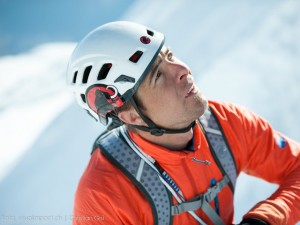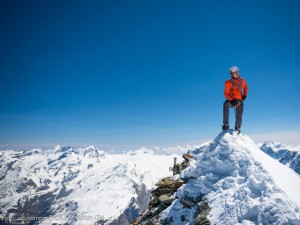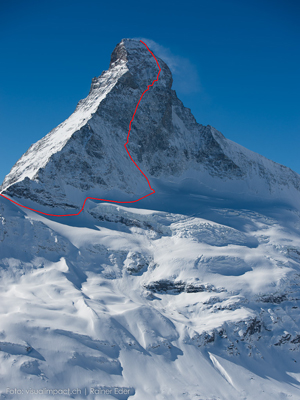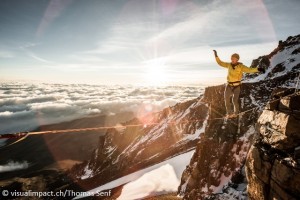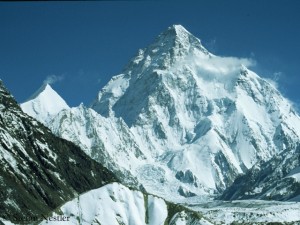Matterhorn: ”For climbing okay, but not very special”
The Matterhorn was his first four-thousander. Dani Arnold was 18 years old when he first scaled the prestige mountain of his home country from the Höernli Hut on the normal route in 2002. Today the 31-year-old is one of the best climbers in Switzerland. Since then, he has been „maybe eight times on top“ of the Matterhorn, Dani writes to me from Pakistan, where he is currently trying to climb first through the North Face of the seven-thousander Latok I, along with the German Huber brothers and the Austrian Mario Walder. In recent years, Arnold made headlines in particular with his speed records. Since 2011, he is holding the record on the Eiger North Face. He climbed the wall on the route of the first ascent in two hours and 28 minutes. Thus Dani was 20 minutes faster than the previous record holder Ueli Steck. This April, he also broke Steck’s speed record on the Matterhorn North Face. It took Arnold an hour and 46 minutes, spending ten minutes less on the wall than Ueli did in 2009. The Matterhorn, 150 years after the first ascent, from the perspective of a professional climber:
Dani, all over the world the Matterhorn is a symbol for Switzerland. How do you see this mountain? Or in other words, what does it mean to you?
In terms of shape, it is one of the most beautiful mountains. Climbing it, is okay, but not very special. The rock often is not solid.
150 years ago, the Matterhorn was first climbed by the roped party of the Briton Edward Whymper. How do you value their performance, taking into account the equipment from then and considering that the group climbed into the unknown?
Of course it was an impressive performance. Respect!
The first ascent ended tragically: Four climbers fell to death. Did this disaster establish the myth of the Matterhorn?
I think so. Mostly tragedies and accidents are the reason that mountains get mythical. Actually, it’s in some way weird, that something has to happen before the public takes notice.
The Matterhorn is a commercial mountain. About 3,000 summit aspirants per year try to climb it. Does the Matterhorn share the fate of other prestige mountains like Mont Blanc or Mount Everest, attracting people who actually do not belong there due to their lack of climbing skills?
It already belongs to this category of famous mountains that attract many people simply because of its name. And thus there are many climbers who actually have no business to be there.
Not a year passes without fatalities on the Matterhorn. Does it make sense to limit the number of ascents?
No, the important thing is that mountaineering has to remain free. That means, anyone can climb where he wants. This is a huge privilege. But everyone has to bear the consequences himself.
Is climbing the Matterhorn, especially via the North Face, still a classic that should not miss in the career of a professional climber?
Everyone should have climbed the wall. However, that must be qualified. The North Face is a classic tour that many people are able to climb. But for us, (professional climbers) it is rather simple compared to current projects. Otherwise alpinism would not have developed since the first ascent of the Matterhorn North Face. 😉
Last April, you set up a new speed record on the North Face. You climbed the wall on the route of the first ascent by Franz and Toni Schmid (1931) in a time of one hour and 46 minutes, thus being ten minutes faster than Ueli Steck. Have you reached your limit or is it possible to climb the wall even faster?
It is always possible to climb faster. 🙂 Many things have to match. I have to be fit enough. The conditions must be okay. The psyche has to be right, and I have to be highly motivated. My climbing time was short, but actually it was strenuous too. 😉
In 2010 and 2011, the Italian climber Hervé Barmasse opened two new routes on the Matterhorn South Face. But such first climbs are seldom. Is the Matterhorn largely exhausted? Is there next to nothing to do for climbers?
I do not believe that. The obvious lines have been climbed. But there is still a lot of room. Many think that you can experience extraordinary things only in the Himalayas. But that’s not true.
If you could make the Matterhorn a present for the 150th anniversary of its first ascent, what would it be?
I’ve never really thought about what you can give to a mountain. 🙂
P.S.: That was the last part of my little Matterhorn series.



